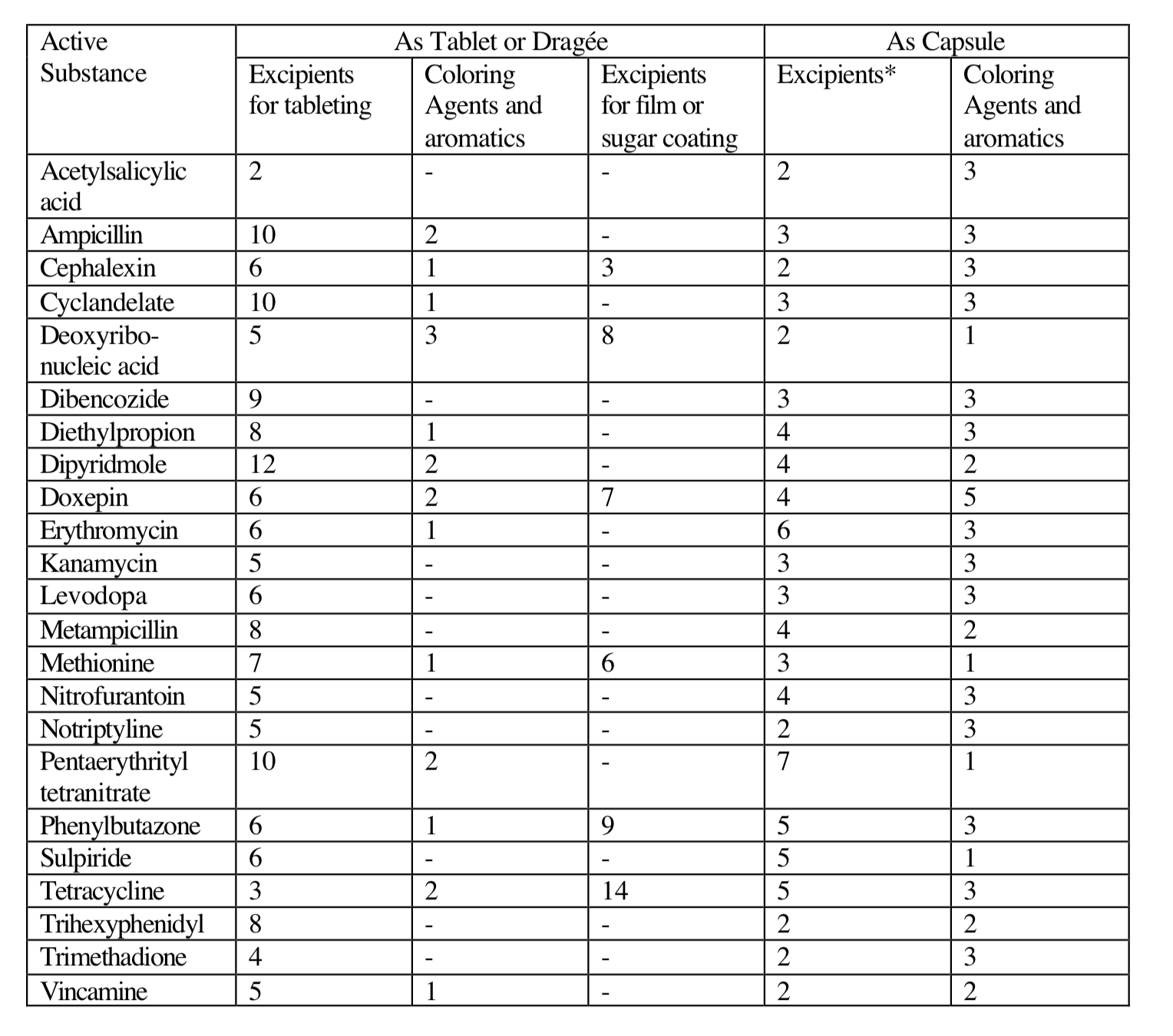EXCIPIENT REQUIREMENTS IN THE FORMULATION OF SOLID ORAL DRUG FORMS

Excipient requirements in the formulation of solid oral drug forms*
* This study was carried out by Capsugel in collaboration with Sophartex, Dreux, France.
The majority of pharmaceutically active substances must be mixed with excipients to obtain an accurate dosage control.
Fillers, as well as disintegrating binding and lubricating agents are physiologically neutral at the concentrations normally used. Preservatives, antioxidants and coloring agents occasionally give rise to signs of intolerance. The problems raised by dyes and the successful search for physiologically unobjectionable coloring agents have already been the subjects of Capsugel reports. Here we will not concern ourselves with the characteristics of the various adjuvant and additives now in use or with the problems they raise (these have been dealt with in a recent review by Hess5). Instead we propose to turn our attention to comparing the excipient requirements of different solid oral drug forms.
In preparing an active substance for filling into hard gelatin capsules, practically the only characteristics that need to be taken into account are dosability, flowability and bioavailability. This makes it a simple matter to produce a formula presenting no problems in manufacture. Nevertheless, much expertise and ingenuity are still called for on the part of the galenist.
Capsugel became aware of this problem some years ago, with the result that a study was undertaken in collaboration with the French firm of Sophartex (News Sheets BAS-863 and BAS- 914) of some of the properties required by excipients suitable for machine filling. This investigation can serve as the basis for formulating future capsule mixtures.
In addition to the above mentioned excipients needed in capsule formulation, tableting mixtures generally contain considerable amounts of lubricants. These substances must be compatible with both the active substance and the excipients, a requirement that renders the galenically satisfactory preparation of active substances for tablets a much more difficult matter than for capsules.
With capsules, the number of excipients needed is considerably smaller, as will be made clear by the following study undertaken in collaboration with Sophartex, while bioavailability is equal or better. The study covered those preparations which are marketed in both tablet and capsule form. As will be seen from Table 1, the aromatics and coloring agents are listed separately from excipients. Color is today the best and most important means of identifying a product, and as an essential characteristic it should be disregarded in comparing the two forms. Coloring agents and aromatics moreover have no influence on active substance formulation.
The comparison (Table 2) shows clearly that capsule formulations are simpler than tableting mixtures. The 23 selected active substances require on average 3 1⁄2 excipients when formulated for capsules compared with 6 for tablet formulations. In other words, the bare tablet requires almost twice as many excipients as the capsule.
Figure 1 makes the difference clearer. In 95% of the formulations for hard gelatin capsules less than 6 excipients are used, while 65% of those for tablets need more than 5 such substances. Yet more striking is the fact that some 85% of all dragée and film-coated tablet mixtures contain between 12 and 17 excipients! In addition, the coating of tablets requires the use of aggressive solvents whose possible effects cannot be ignored. Even when the comparison covers other excipients like aromatics and coloring agents – whereby as already pointed out color is practically a necessity and has no effect on the formulation – the tablet and especially the dragée and film-coated tablet remain much more complex drug forms.
Table 1 Excipient requirements of active substances in tablet, dragée and capsule form.
The advantages of the hard gelatin capsule as drug form with a low excipient content can be summarized as follows:
- In the hard gelatin capsule the active substance mixture is compressed to an insignificant extent, if at all. This state of minimum contact means that interactions between the components are much less likely than in the tableting process.
- Modern excipients are mostly commercial products available in the desired quality only from a few suppliers. This situation can lead to dangerous dependence on other firms and is one reason why pharmaceutical manufacturers prefer to use as few excpients as possible.
- Registration of a new product can be held up by the need to undertake toxicological testing of a recently developed excipient.
- To be sure of maintaining a constant high level of bioavailability, the purity and technical characteristics of the excipients must be regularly checked. The fewer the excipients used, the lower the running costs of analysis.
Preparation of the active substance for hard gelatin capsules is simpler and as a rule faster. Development costs are therefore lower than for other oral forms. - Since a new preparation can usually be developed faster in capsule form than as tablets, the time needed to launch the final product is shorter if it is made up in capsules. This is a very important advantage at the present time, when it is becoming more and more common for the same p0reparation to be marketed by different manufacturers. The manufacturer who gets the new product fastest onto the market is the one who is likely to get the largest share.
Download the full Capsugel publication here: Excipient requirements in the formulation of solid oral drug forms


